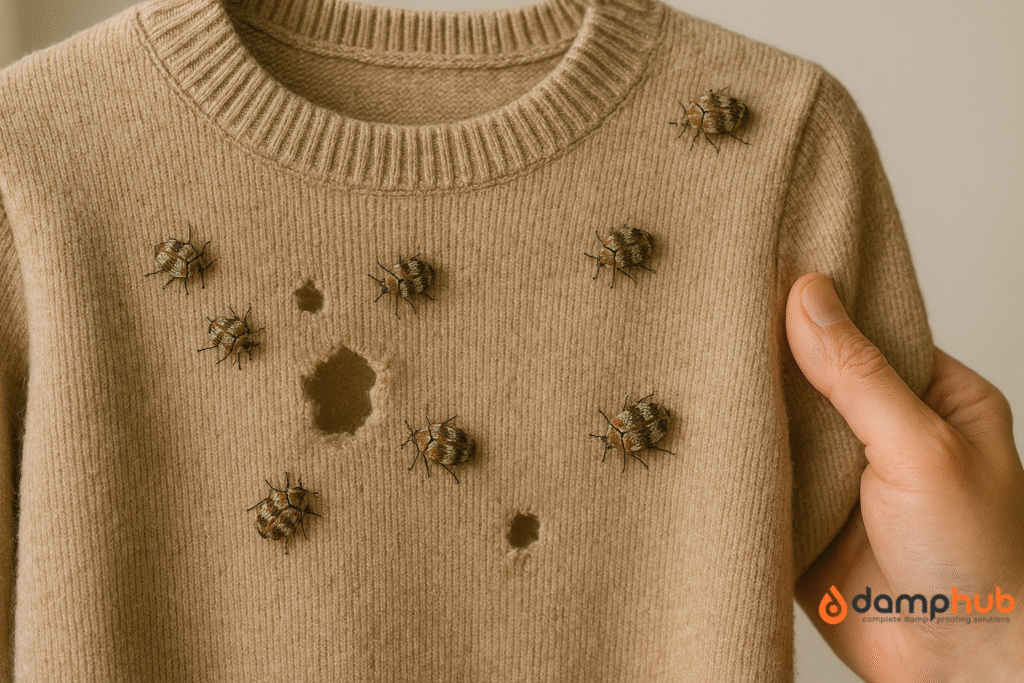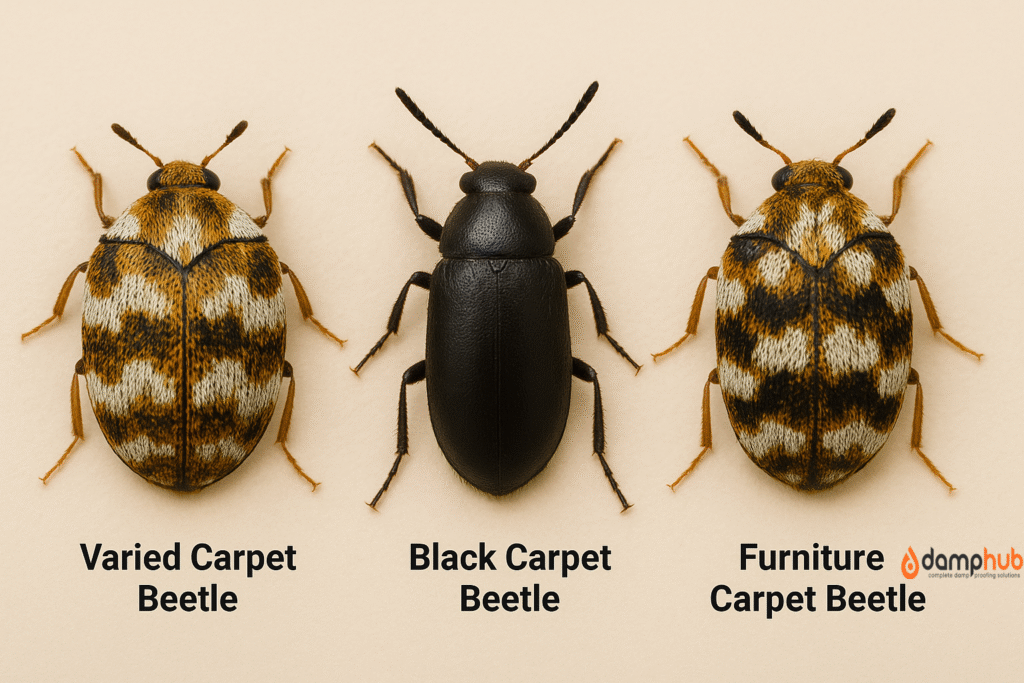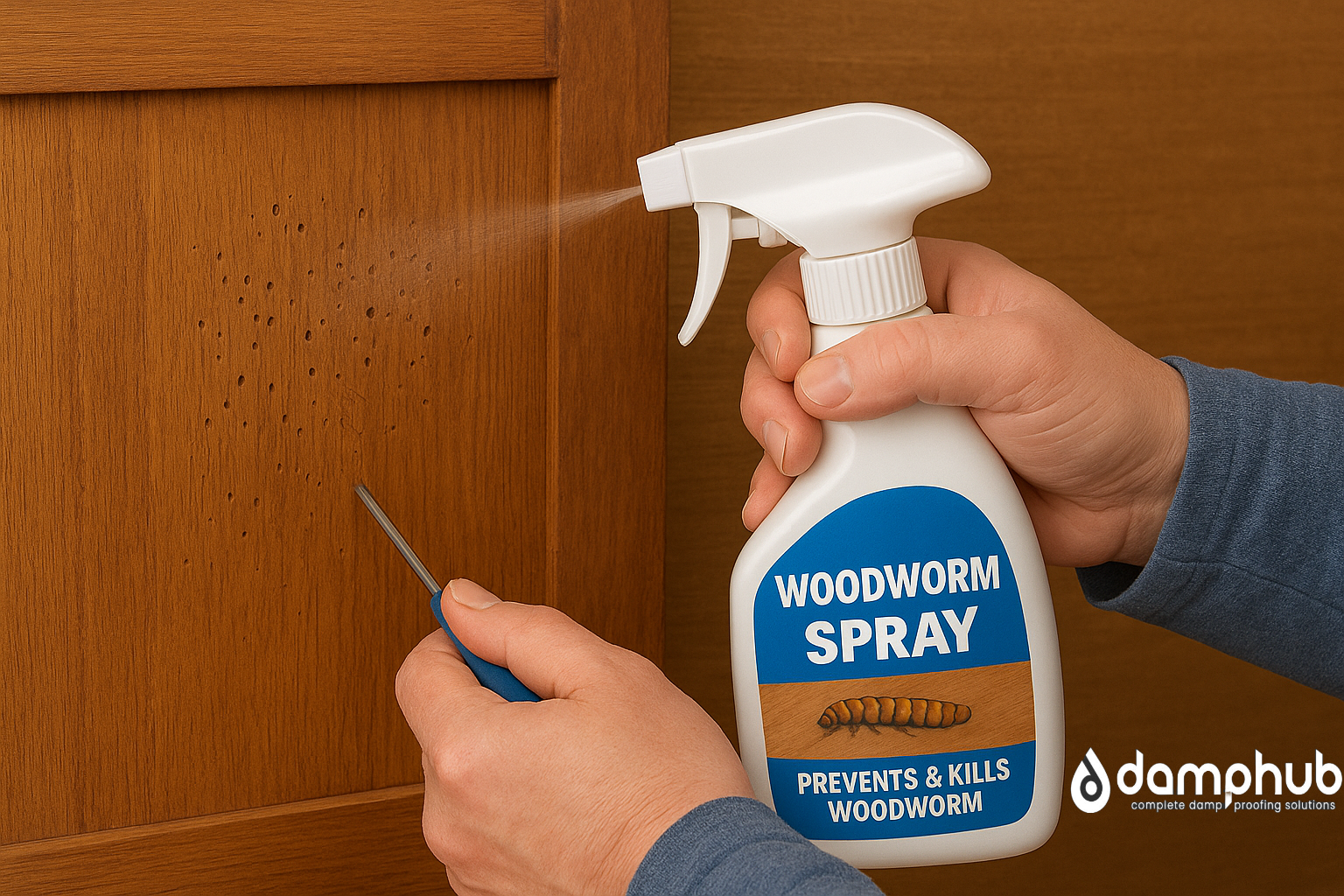
You’ve probably spotted one and thought, “Is that a tiny, dusty ladybird?” Close. But not quite.
That speck with fancy patterns on your windowsill? It’s likely a varied carpet beetle—a harmless-looking insect that turns into a wardrobe-wrecking, skin-irritating nuisance once it settles in.
Let’s get under its tiny wings and figure out what makes this pest tick—how to get rid of carpet beetles, and stop it from turning your soft furnishings into snacks.
What Is a Varied Carpet Beetle?
Officially known as Anthrenus verbasci, the varied carpet beetle is a tiny insect with a big appetite for your belongings.
- Named for its patchy appearance: white, brown, and yellow scales that give it a mottled look.
- It’s one of the most common carpet beetles in the UK and US homes.
- The beetle itself isn’t the main issue—it’s the larvae that cause damage.
These beetles are experts at disguise. Tap one, and it goes limp—like an actor faking fainting in a soap opera.
They love hidden, quiet spaces: behind picture frames, inside old books, or nestled deep in wall insulation. If there’s a calm corner, they’ll claim it.
And here’s the twist: while the adult beetle doesn’t feast on your clothes, it lays the groundwork—literally. It’s the flying postman delivering trouble in tiny eggs.
What Does a Varied Carpet Beetle Look Like?
- Size: tiny—just 2 to 3.5 mm
- Shape: dome-like, almost round
- Colour: a confetti mix of white, yellow, brown, and black
At first glance, they pass for a cute bug. Look closer, and they’re the textile version of termites.
Their larvae? Think of them as hairy breadcrumbs that bite back.
If you see more than one adult near your windows, it’s probably not a coincidence—they’re scouting. That’s your sign to check your favourite cardigan before it becomes confetti.
A magnifying glass might seem over the top, but it helps spot the enemy before the damage starts.
Must also read👉How to Treat Carpet Beetle Rash
What Do Varied Carpet Beetles Do?
Adults spend their days flitting around flowers and open windows. They’re harmless.
But their offspring? That’s where the horror story begins.
- Larvae feed on natural fibres: wool, silk, feathers.
- They’re not picky. They’ll chomp through cashmere as happily as dog hair on a rug.
- They hide in places you rarely clean—under sofas, inside drawers, even in air vents.
They’re not neat eaters either. Instead of clean holes, they leave ragged bald spots—as if a moth threw a tantrum.
And if you’re sentimental about keepsakes like dried flowers or handmade dolls? Sorry—they’re on the menu too.
Adult Beetles Vs Larvae: Quick Comparison Table
| Feature | Adult Beetle | Larvae (“Woolly Bear”) |
|---|---|---|
| Size | 2–3.5 mm | Up to 5 mm |
| Appearance | Dome-shaped, mottled (white, yellow, brown) | Bristly, brown, cigar-shaped with stripes |
| Activity | Flies around windows, active in daylight | Hides in dark corners, crawls slowly |
| Damage Caused | None (harmless to fabrics) | Yes – chews through natural fibres |
| Where Found | Window sills, flowers, light sources | Under carpets, in drawers, behind furniture |
| Lifecycle Role | Lays eggs | Feeds and causes fabric damage |
Why Are Varied Carpet Beetles a Problem?
They’re silent, they’re sneaky, and they multiply like party crashers at an open-bar wedding.
Read more here: How to Prevent Carpet Beetle Infestation
Here’s the real trouble:
- Clothes and fabrics get shredded
- Their hair can cause skin reactions and itchy rashes
- They hide where you’d least expect—like behind skirting boards or deep inside heating vents
One minute, your winter coat is pristine. A month later? It’s full of patchy, mysterious baldness.
They thrive on neglect. The darker, quieter, and more forgotten a corner is, the more likely they’re in it.
And a single female beetle can lay up to 100 eggs. That’s not a bug problem—that’s an invasion waiting to happen.

Where Do Varied Carpet Beetles Live?
They aren’t fussy. Anywhere that offers a cosy hideaway will do.
Indoors:
- Under carpets and rugs
- Behind furniture
- Inside air ducts, wardrobes, or that one drawer you never open
Outdoors:
- Bird nests, tree bark, and garden flowers
- They hitchhike on cut flowers or second-hand goods
That charming thrifted jumper? Could be hosting a family reunion.
If you have birds nesting nearby or gaps in attic vents, you may as well roll out a tiny red carpet.
How Can You Tell If You Have Varied Carpet Beetles?
They’re small, but they leave a trail like glitter—hard to clean and oddly telling.
Look for:
- Shed larval skins: brown, crispy, and usually tucked in corners
- Bald spots in wool rugs or chewed clothing seams
- Tiny, slow-moving larvae covered in bristles
- Adults lounging around light sources
- Frass (bug droppings) that looks like gritty dust
You may even feel phantom itches or spot red bumps—like your skin’s trying to drop you hints.
If it looks like lint but wiggles… well, it’s not lint.
Read more from us👉 What Is Woolly Bear Carpet Beetle?

How Long Do Varied Carpet Beetles Live?
- Adults: 2 to 6 weeks—just long enough to flirt, mate, and lay eggs
- Larvae: several months, or even a year, depending on temperature and food
They grow faster in warm, centrally heated homes. Basically, they love the same cosy conditions we do.
Can Varied Carpet Beetles Harm Humans?
Not in the traditional monster-under-the-bed sense.
They don’t bite or sting. But they can still cause misery:
- Their hair can trigger allergic reactions and itchiness
- Some people develop rashes or asthma-like symptoms after contact
Handling stored jumpers and getting suddenly itchy? You might not be imagining things.
Wash your hands after sorting old clothes or second-hand fabrics. It’s a habit that’ll save you from scratching later.
How Do You Get Rid of Varied Carpet Beetles?
Time for action. This isn’t a passive battle—you need to be thorough.
- Vacuum like your carpets owe you money, especially edges and under furniture
- Wash everything possible in hot water (60°C+)
- Steam clean where heat won’t ruin the fabric
- Seal clothes in tight, bug-proof containers
- Use sprays with IGR (insect growth regulators) or sprinkle diatomaceous earth
Spot one beetle? Act like there are fifty.
And never, ever forget to empty your vacuum bag outdoors. Otherwise, you’re just giving them a lift to another room.
Must also read 👉How to Identify and Get Rid of Black Carpet Beetles
Are Varied Carpet Beetles the Same as Other Carpet Beetles?

Not quite—but they’re all trouble.
Close cousins include:
- Black carpet beetles: darker, longer, and just as hungry
- Furniture carpet beetles: rounder, and—as the name suggests—partial to sofas
Think of them as different flavours of the same problem. If it’s wool, silk, or fur, they’re all in.
You don’t need to become an entomologist. If you’ve got one, treat it like you’ve got them all.
| Feature | Varied Carpet Beetle | Black Carpet Beetle | Furniture Carpet Beetle |
|---|---|---|---|
| Scientific Name | Anthrenus verbasci | Attagenus unicolor | Anthrenus flavipes |
| Size | 2–3.5 mm | 3–5 mm | 2–3 mm |
| Colour | Mottled (white, brown, yellow) | Solid dark brown or black | Speckled, duller tones |
| Shape | Dome-like | Elongated | Round and compact |
| Common Hideouts | Windowsills, corners | Pantries, baseboards | Upholstered furniture |
| Damage Risk | High – targets clothing and wool | High – also feeds on grains | Moderate – prefers upholstery |
| Larvae Type | Bristly, slow-moving | Long, smooth-bodied | Short, densely covered in hairs |
Final Thoughts
They may be small, but varied carpet beetles have big plans—and your home’s in their sights.
Don’t let their size fool you. Regular checks, good storage habits, and proper cleaning can keep your space safe.
Because of that speck on your curtain? It could be the start of a six-legged takeover.
Catch them early. Keep them out. And maybe, just maybe, your jumpers will live to see another winter.
What Is a Varied Carpet Beetle: Common Questions Answered

-
Do carpet beetles lay eggs in human hair?
No, carpet beetles do not lay eggs in human hair. They prefer dark, undisturbed areas where natural fibres like wool, fur, and feathers are present.
While their larvae may be found near hair in brushes, carpets, or bedding, they don’t lay eggs on the human body or scalp.
-
What is the difference between varied carpet beetles and furniture carpet beetles?
Varied carpet beetles (Anthrenus verbasci) have a mottled appearance with white, brown, and yellowish scales and are more commonly found in homes.
Furniture carpet beetles (Anthrenus flavipes) are slightly larger and darker, with more uniform colouring and lighter bands.
Both species damage natural fibres, but their appearance and typical hiding spots differ slightly.
-
Are varied carpet beetles poisonous?
No, varied carpet beetles are not poisonous. They don’t bite, sting, or transmit disease.
However, their larvae are covered in bristly hairs, which can cause skin irritation or an allergic reaction in some people.
This is sometimes misidentified as insect bites, but it’s a form of contact dermatitis, not poisoning or biting.
-
What month are carpet beetles most active?
Carpet beetles are most active during spring and summer, especially from May to August in the UK.
This is when adult beetles emerge, mate, and lay eggs indoors. Infestations often become noticeable during these months as larvae begin feeding on carpets, clothing, and upholstery.
-
What scent do carpet beetles hate?
Carpet beetles dislike strong-smelling natural oils such as cedarwood, eucalyptus, clove, peppermint, and lavender.
These can help deter adult beetles and larvae when used in sachets or sprays.
However, scents alone won’t remove an infestation — they’re only useful as part of a broader prevention strategy.
-
What happens when you get bitten by a beetle?
Most beetles found in UK homes, including carpet beetles, do not bite humans.
If you’re experiencing red, itchy patches, it’s likely caused by an allergic reaction to the hairs of carpet beetle larvae, not an actual bite.
The irritation may resemble a rash, but there is no venom or puncture involved. Our full guide👉 How to Prevent Carpet Beetle Bites?
-
What happens if you accidentally eat a beetle?
Accidentally consuming a beetle or insect fragment — for example, from contaminated dry goods — is not usually harmful.
Most household beetles are non-toxic and pose no serious health risk if ingested in small quantities.
However, it’s best to discard any infested food to avoid potential stomach upset or contamination.
-
How long does a bug bite last?
Most insect bites or allergic skin reactions last a few days to a week, depending on the individual.
Carpet beetles don’t bite, but irritation from their larvae can linger for several days.
If symptoms persist or worsen, a pharmacist or GP should be consulted.
-
What ointment do you use for beetle bites?
Since carpet beetles don’t bite, any skin reaction is likely due to larval hairs.
You can treat it with an over-the-counter hydrocortisone cream, antihistamine cream, or calamine lotion to reduce itching and redness.
If the area becomes swollen or infected, seek medical advice.






